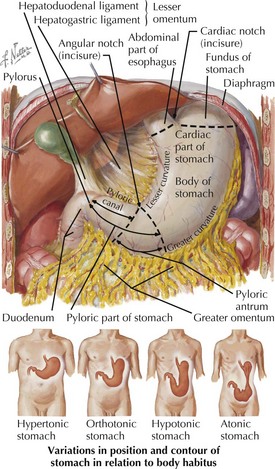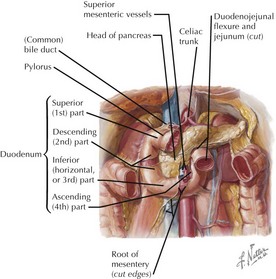10 Gastroduodenal Diseases
Anatomy of the Stomach and Duodenum
Parts of the Stomach
• Greater curvature, lesser curvature, inferior and superior borders (respectively) of the voluminous body of the stomach
Functional Anatomy and Motility
• Receptive relaxation and accommodation occur in the proximal 1/3 of the stomach, with swallowing and entry of food.
• True peristalsis occurs in the distal 2/3, with waves of contraction driving the contents back and forth between the body and antrum (trituration).
• Small amounts of triturated stomach contents pass through the pylorus with successive peristaltic waves.
Gastric Microscopic Anatomy
Anatomy of the Duodenum
• Superior (first) part
 Ampulla (cap)—first 2 cm—bears a mesentery, the hepatoduodenal ligament, part of the lesser omentum.
Ampulla (cap)—first 2 cm—bears a mesentery, the hepatoduodenal ligament, part of the lesser omentum.
 Ampulla (cap)—first 2 cm—bears a mesentery, the hepatoduodenal ligament, part of the lesser omentum.
Ampulla (cap)—first 2 cm—bears a mesentery, the hepatoduodenal ligament, part of the lesser omentum.• Descending (second) part
 Receives the outflow from bile and pancreatic ducts via the hepatopancreatic ampulla (Vater) through the greater duodenal papilla (Vater)
Receives the outflow from bile and pancreatic ducts via the hepatopancreatic ampulla (Vater) through the greater duodenal papilla (Vater)
 Receives the outflow from bile and pancreatic ducts via the hepatopancreatic ampulla (Vater) through the greater duodenal papilla (Vater)
Receives the outflow from bile and pancreatic ducts via the hepatopancreatic ampulla (Vater) through the greater duodenal papilla (Vater)























